
Part XI, section 3 of the Rules for Submissions for the S.C.A. College of Arms says:
What does that mean, and how can you avoid running afoul of this
rule when designing your armory?
In the Middle Ages and Renaissance, heraldic devices were valuable
property, both in and of themselves and because they represented
claims to lands and titles. Like other valuable property, they
were inherited by others upon their owners' deaths. As you would
expect, there were circumstances in which a single individual
inherited the right to bear more than one heraldic device. Sometimes
he would simply use the more prestigious device (one associated
with the more influential branch of the family, or inherited from
a more impressive ancestor, for instance). Sometimes he would
be loath to give up the opportunity to show off his ties to multiple
important people and lines, his many feudal claims, and his general
impressive muckety-muckiness, and he would, instead, marshal
his arms, combining the previously independent devices
into one.
To make things more complicated, sometimes a woman would be identified by her father's arms marshalled with those of her husband. Sometimes a man would marshal his arms with the arms of his wife's father and use that as his arms (especially if said father's family was more influential or impressive than his own). Sometimes, a man holding an important post would be identified by a marshalling of his personal arms and those that represented his office. And sometimes arms were marshalled to show allegiance.
Marshalling became more common (and more elaborate) as time wore on, and some late-period arms are ridiculously complex as a result of multiple generations of its use (or of heraldic fraud by those who merely wished to be believed to have the kinds of connections such devices implied).
Since marshalled arms were in period associated with hereditary nobles, the S.C.A. considers using them tantamount to claiming inherited rank. As the S.C.A. has no inherited rank, such a claim would, in the context of the Society, be spurious. Therefore, members of the S.C.A. are not permitted to register marshalled devices or devices that look like they were created by marshalling.
Fortunately, this rule doesn't affect too many types of devices. While rules and customs regarding the use of heraldry varied from place to place and over time, there were some general patterns that were broadly applied across much of Europe. There are two ways of combining arms that account for almost all known instances of period marshalling: quartering and impalement.
When two sets of arms are combined by quartering, they are presented in the alternating sections of arms quarterly.

When two sets of arms are combined by impalement, they are presented in the respective halves of arms party per pale.
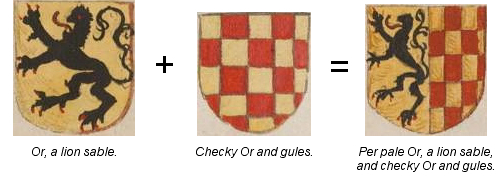
Ordinarily impaled arms are presented in full, but sometimes they are dimidiated along the line of division. (E.g., only half of one or both of them is shown.)


Because these approaches are so nearly universal, you usually only have to worry about the appearance of marshalling when you're using a quarterly or per pale field division in your armory.
Not all devices using quarterly or per pale fields look marshalled. The Rules for Submissions give us some guidelines we can use to determine whether a given piece of armory does. First, they give us a list of reassurances.
It is certainly possible that an individual might inherit two separate sets of arms with different field tinctures and identical charges, but it's improbable. Therefore, a device that has the same charge(s) in each section of a quarterly or per pale field doesn't automatically call marshalling to mind.
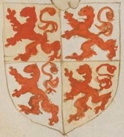
Remember back at the beginning of this article, when I said there were certain rules and customs that were broadly applied, across Europe, when people marshalled their arms? Well, one of them was "use straight lines". So, even if it would otherwise appear to be marshalled, a device that has a complex line of division between its sections doesn't.

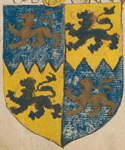
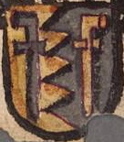
There are a few types of charges which, in period, were sometimes added over the top of marshalled arms to communicate specific pieces of information about the people bearing them. For instance, in some places at some times an illegitimate son could inherit his father's arms, but would place a bend sinister, a baton sinister, or a bordure ermine on them in acknowledgement that they had passed from the legitimate line. Similarly, in some places, at some times, a man's arms were carried by his sons with the addition of charges known as marks of cadency, like these:


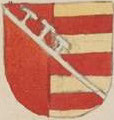
Aside from such special markers, no charge on marshalled arms would cross the line of division between one section and another. Therefore, if any of its charges do, other than those that were used in period as additions to marshalled arms, a device doesn't look marshalled.
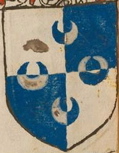
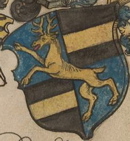
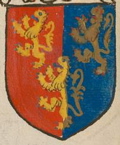
Next come a list of prohibitions.
Ordinaries, by definition, end where the field ends. If you end one at the edge of a section of a quarterly or per pale field, it implies that that section, by itself, constitutes a field. That creates a pretty strong impression of marshalling. For that reason, you cannot cut an ordinary short or shrink it down to make it fit in just one section of those kinds of fields, as has been done in these marshalled arms:


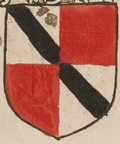
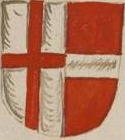
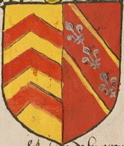
This also applies to fields that are made up of multiple ordinaries or diminutives of ordinaries, like gyronny, barry, paly, and bendy.

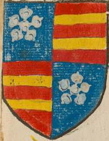
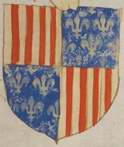

Most of the time, multiple charges on heraldic arms are more-or-less evenly distributed over the field, either scattered across it at random or placed on it in one of a handful of traditional arrangements. Asymmetrically-placed clusters of charges are unusual enough that when such a cluster is seen in one section of a per pale or quarterly field the explanation that leaps to mind is that the section in question was once independent arms. Here are some examples of such patterns in period arms:

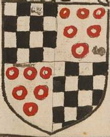


"Same type" means the same sort of thing (all circles, or all scissors, or all dogs). All of these arms would, if submitted as S.C.A. devices, fall afoul of this rule.
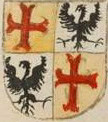

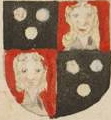
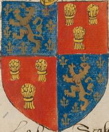

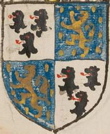
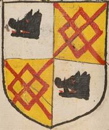
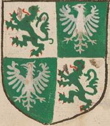

If you keep these guidelines in mind, you'll be much less likely to design a device that violates RfS XI.3. You must remember, however, that they are only intended to make it easier for you to avoid the problem. Ultimately, any piece of armory that, in the opinion of the sovereigns at arms, appears to be marshalled can and will be returned whether it can be matched to one of the above prohibitions or not. The issue is not always black-and-white.
For example, in period an individual sometimes inherited two sets of arms with the same field tincture. When these were marshalled, the resulting arms had a single field tincture. The reassurances and prohibitions in the Rules for Submissions only apply to armory with divided fields, so they don't help us evaluate devices that resemble these arms. The sovereigns at arms might allow them, or they might not.
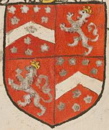



In addition, crosses are among those few special charges mentioned above that are sometimes placed overall on marshalled arms. As a result a device featuring a cross with alternating charges around it might be considered to look like marshalled arms with a single field tincture. Again, whether the impression is strong enough to warrant a return can only be determined by the sovereigns at arms.
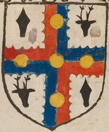
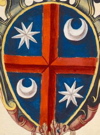
If, after reading this article, you remain unsure whether the device you've got in mind is too similar to marshalled arms, show it to a few heralds and ask their opinions. Maybe they can resolve the issue for you, or maybe they'll be able to recommend something similar that's in the clear. There are consultation tables at most big events where this would be easy to accomplish, or you could upload an image of the proposed device to the Web and ask for opinions by e-mail.
The illustrations in this article are all from 16th-century armorials in the collection of the Bavarian State Library. Most of them come from BSB Cod.icon. 265, which was painted in Flanders, or BSB Cod.icon. 291, which is English. "Quarterly Or and argent, four lions gules" is from BSB Cod.icon. 286, which is probably from Italy. "Azure, a cross gules between in bend two mullets of eight points and in bend sinister two crescents argent" is from BSB Cod.icon 270 "Per pale gules and bendy sable and argent" is from BSB Cod.icon. 307. "Quarterly azure and sable, a fess Or, overall a stag rampant Or" is from BSB Cod.icon 391. And "Per pale indented Or and sable, two crutches counterchanged" and "Per pale Or, a demi-two-headed-eagle and gules, a bend argent" are from BSB Cod.icon. 207. All three of these are German. All of these armorials contain many additional images of marshalled arms, and would be good resources for someone trying to learn more about the practice.
 Coblaith Muimnech holds
the copyright to this document, including all illustrations not
excerpted from works more than 300 years old. It is made available
under a Creative Commons Attribution-Noncommercial-Share
Alike 3.0 United States License.
Coblaith Muimnech holds
the copyright to this document, including all illustrations not
excerpted from works more than 300 years old. It is made available
under a Creative Commons Attribution-Noncommercial-Share
Alike 3.0 United States License.